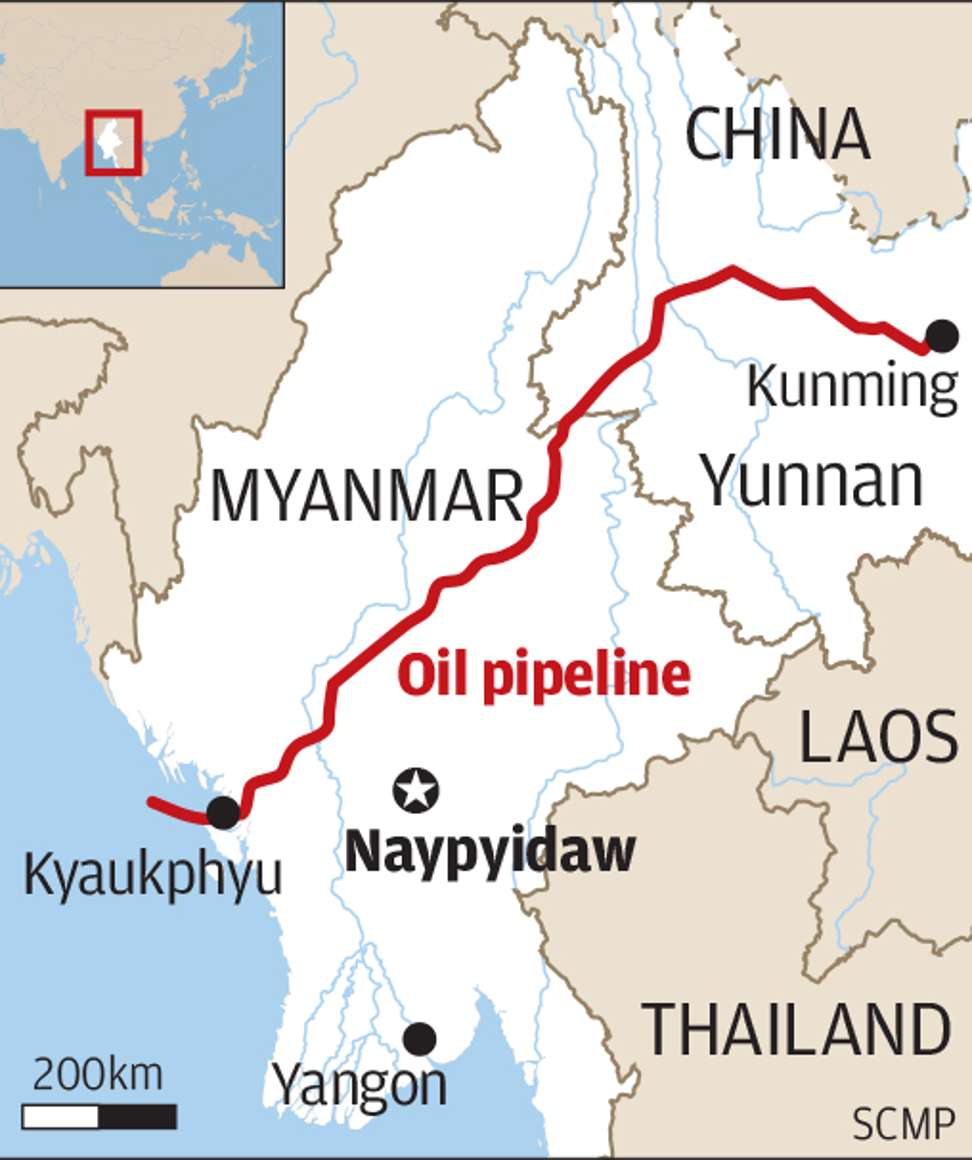
Myanmar pipeline gives China faster supply of oil from Middle East
Link allows crude imports to arrive without using Malacca Strait
A crude oil pipeline to southwestern China through its neighbour Myanmar began operations after years of delays, allowing the world’s second-biggest oil user to receive supplies faster from the Middle East and Africa.
A Suezmax-sized tanker, which can hold 140,000 tonnes (about 1 million barrels) of crude, began offloading oil for the pipeline on Monday at Myanmar’s Made Island, according to Xinhua. Operations on the line, which was completed in 2014 and originally scheduled to start the same year, were beginning after the government of Myanmar agreed to lower transit fees, Wang Dongjin, the president of PetroChina, said last month.
The link, which allows China to import crude from the Middle East and Africa without having to ship through the Strait of Malacca and into the South China Sea, is part of President Xi Jinping’s “One Belt, One Road” infrastructure and trade development plan stretching across Asia to Africa and Europe.
“It may send a message to those countries that are still hesitating about whether to participate that the initiative is China’s top national strategy and can bring economic benefits to participants,” said Fan Hongwei, an international relations professor at Xiamen University.

Trial operations began in 2015 on the 771km pipeline, which is designed to carry 22 million tonnes of crude a year. Myanmar could take 2 million tonnes annually from it, Xinhua said.
For Myanmar, the initial benefits were probably minimal, said Suresh Sivanandam, a senior research manager at Wood Mackenzie. It might get a small amount of oil and some revenue from oil storage and pipeline tariff fees, while experience from China in building energy infrastructure would be a boon later, he said.
“Myanmar is growing very fast, and sooner rather than later they might need more oil refineries,” Sivanandam said. “The process of building energy infrastructure should help them in the long run to meet growing domestic demand.”
The Suezmax tanker United Dynamic arrived at Myanmar around Sunday after loading oil from the Baku-Tbilisi-Ceyhan terminal in Turkey on March 5, according to ship-tracking data compiled by Bloomberg.
The pipeline ends in China’s Yunnan province, where PetroChina has built an oil refinery with the capacity to process 13 million tonnes a year of crude.
China’s biggest oil and gas company was in talks with Saudi Arabian Oil Company about investing in the plant, which would begin operations in June, Wang said last month.
PetroChina finished building the refinery in the provincial capital Kunming about six months ago and has been waiting for pipeline deliveries to start, according to Sivanandam. It would take about 12 million barrels of crude to fill the pipeline before deliveries could start, he said.
Once the refinery started up, it would sell products in the southwest mainland, displacing petrol and diesel from refineries in central and southern parts of the nation, he said. That will likely increase the country’s net exports of refined products, which rose to a monthly record of 2.85 million tonnes in November.
China and Myanmar on Monday signed an agreement on the pipeline, as well as eight other cooperation documents, after talks between Xi and Myanmese President Htin Kyaw, who was visiting China from Thursday to yesterday, China Daily reported.
China’s crude imports rose almost 14 per cent last year, the fastest annual pace since 2010, and touched a record in December of 8.6 million barrels a day.
“It opens another channel for China to diversify oil imports,” said Tian Miao, an analyst at North Square Blue Oak in Beijing.
China is also fed by a parallel natural gas pipeline that runs through Myanmar to Yunnan province, designed to carry 12 billion cubic metres annually. PetroChina’s parent company, China National Petroleum Corporation began to import gas from Myanmar in 2013, according to a statement on its website. Shipments totalled 2.86 million tonnes last year, customs data showed, accounting for about 5 per cent of the country’s total imports.
Companies including Total and Woodside Petroleum are exploring for resources off shore of Myanmar.
The country had about 3.4 per cent of the Asia-Pacific region’s total proven gas reserves as of 2015, according to BP data.

